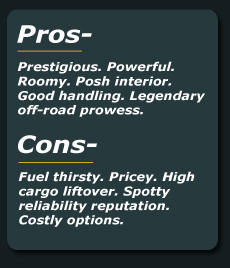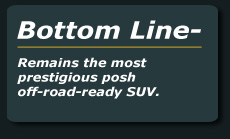2011 Range Rover
The 2011 Range Rover is still lord of the manor
Prices: $78,835-$94,615
There is no topping the Range
Rover, which is still lord of the manor. After all, it was the first
off-road ready luxurious SUV. It was introduced in 1970, but
didn’t reach America until 1987.
Still, many Americans had seen it before its U.S. debut in adventure
movies set in such locations as Africa, and it had a well-deserved
reputation for being tough and adventuresome. Never mind that it had a
spotty reliability reputation and a modified 3.5-liter aluminum
ex-Buick V-8 from the 1960s.
The first Range Rover here came from the Land Rover division of
England’s state-owned Rover group, which always managed to
botch things up, and was costly at about $30,000. It was the most
upscale SUV, and its legendary off-road abilities added to its sex
appeal. However, most Range Rover owners felt it was too precious to
take off-road.
The Range Rover never has been inexpensive. The standard 2011
HSE version is $78,835 and the S/C (supercharged) version
lists at $94,615. However, they should last just about forever, without
losing snob appeal.
The Range Rover always has been as British as afternoon tea and has had
incredible snob appeal for many Americans. There are only two global
SUVS that have been around a long time—Range Rover and Jeep.
And, well, a Jeep just doesn’t cut it in the snob appeal
area, compared to a Range Rover.
Nearly everyone from international rock music stars to members of
England’s royal family have driven Range Rovers. Although it
was never a thing of beauty, a Range Rover was exhibited at the Louvre
in Paris as an example of modern sculpture.
Land Rover actually has been making rugged four-wheel-drive vehicles
since 1948, making its debut at the Amsterdam Auto Show. It drove like
a car and labored like a truck, and everyone from farmers to police and
military personnel fell in love with it.
By the early 1960s, the Land Rover was marketed as being trendy and
upscale, although it still was mainly a workhorse. During the frenetic
1960s, it was fashionable in swinging London to own a British Morgan
sports car, Mini Cooper—and a Land Rover.
The first Range Rover was a boxy two-door vehicle with only a
four-speed manual transmission and full-time four-wheel-drive. It was
never intended to double as a passenger car. But the more stylish,
luxurious Range Rover with four doors, an automatic transmission and
such items as Connolly leather upholstery filled that role, introduced
in 1970.
Ford owned the Land Rover operation since 2000. BMW had bought Land
Rover from the British in 1994 and spent $1.3 billion to improve its
Range Rover, which had become rather old and tired. BMW lost a bundle
on the Rover auto operation, which led it to spin off Land Rover to
Ford for $2.6 billion, although it kept the Mini car operation. Ford
thus got the new Range Rover as part of the deal, and BMW agreed to
supply its 282-horsepower V-8s for a while.
Ford improved the Range Rover, concentrating on better quality, and
gave it powerful Jaguar V-8s because Ford then also owned
Jaguar, although it eventually sold both makes to India's Tata Motors
to
concentrate on its own line of cars.
The Range Rover still has a reputation for spotty reliability, but now
carries a four-year/50,000-mile limited warranty, besides 24-hour
roadside assistance. There also is complimentary scheduled maintenance
on the first service at 15,000 miles.
This brings us to the latest Range Rover. It was given two new
Jaguar-derived V-8s in 2010 and they continue to power the
current model. The HSE has 5-liter unit with 375 horsepower and the S/C
has a supercharged 5-liter V-8 with a whopping 510 horsepower.
Both make the Range Rover fast, although it weighs 5,697 to to 5,891
pounds.
That’s an awful lot of weight, but so what if
you’ve got all that power? The 375-horsepower Range Rover
does 0-60 mph in just 7.2 seconds, with a 130-mph top speed, while the
supercharged version hits 60 mph in 5.9 seconds and tops out at 140 mph.
The engines work with a responsive six-speed electronically controlled
automatic transmission with normal, sport and manual shift modes.
As one might guess, fuel economy isn’t a strong point, with
all that power and weight. The Range Rover delivers an estimated 12 mpg
in the city and 18 on highways, although a good driver should be able
to coax 20 mpg during steady highway cruising. Premium fuel is
required, and the fuel tank capacity is 27.6 gallons.
One might suspect that driving the high, heavy Range Rover would be
somewhat tiring, but that’s not the case. The new test
375-horsepower Range Rover I drove was very quiet and
incredibly refined.
The nicely geared steering isn’t too quick for off-road
driving or too slow for on-road motoring. The ride is smooth on all
roads, and handling is quite good, especially for such a big guy.
Powerful anti-lock brakes are controlled by a pedal with a linear
action for consistently smooth stops.
While the weight is felt during quick moves, much of it is kept low in
the Rang Rover to provide a lower center of gravity for better handling.
Enhancing handling are a sophisticated four-wheel-drive system,
electronic traction control, all-terrain dynamic stability control,
enhanced understeer control, cornering brake control, roll stability
control and enhanced hill start assist and gradient acceleration
control.
Safety items include a bunch of air bags.
It takes a little extra effort to get into the roomy interior, which
looks Rolls-Royce sumptuous. The heated front/rear seats (also
ventilated on S/C version) are generally supportive, but could use more
lateral support. The large controls can be easily used. Traditional
physical instruments are replaced by a 12-inch Thin Film Transistor
screen that presents essential driver information via virtual dials and
graphical displays.
Occupants sit high, and the driver has good all-around visibility.
However, a driver will find the shift lever gets in the way of the
console cupholders. And the wide opening to the large cargo
area is high.









 Exterior
detail improvements include new “Jupiter” grilles
and side vents for the non-supercharged HSE version.
Exterior
detail improvements include new “Jupiter” grilles
and side vents for the non-supercharged HSE version.
New for 2011 are an $1,800 Vision Assist Package with blind spot
monitoring and a surround camera system.
There are numerous individual and package options. They include a
$2,500 rear seat entertainment system and $2,000 adaptive cruise
control.
A new Autobiography Black 40th Anniversary Limited Edition celebrates
the 40th anniversary of the debut of the first Range Rover with a
unique finish in Barolo Black, 20-inch Diamond Turned alloy wheels and
a unique grille and side vents with a new mesh.
It’s finished off by an “Autobiography
Black” tailgate badge. The interior also can be customized.
The old saying is that “There always will be an
England.” If so, there “Always will be a Range
Rover.”







